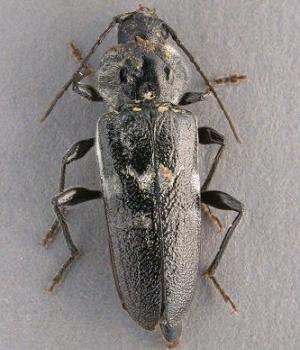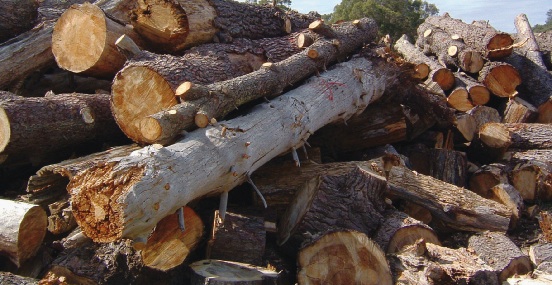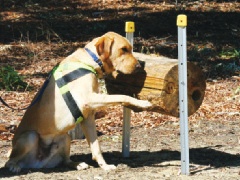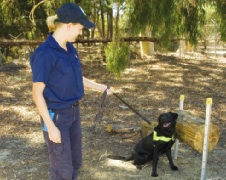PESTS AND DISEASES OF FORESTRY IN NEW ZEALAND
New Zealand's part in Australia's fight with the European hose borer
From Biosecurity 89, February 2009.
Australia is working to eradicate European House Borer, which without action has the potential to spread across the southern half of the country and cost billions of dollars to control and in repairing damage to wooden homes.

In January 2004, the Department of Agriculture and Food in Western Australia received a phone call from member of the public who had heard scraping noises coming from a wooden beam installed in an extension to her house. She also found some sawdust on the ground below the beam.
Entomologists responded to the call and found a single adult female beetle emerging from the pine beam. The beetle was identified as Hylotrupes bajulus, or European House Borer (EHB).
EHB is a pest of seasoned softwood timber exotic to Australia. It specifically attacks seasoned pine, spruce and fir. Its larvae are known to cause significant damage in structural softwood timber in buildings, and can also attack furniture. In this instance, in the Perth suburb of Parkerville, the timber beam was infested prior to installation and originated from a local pine wood dealer.
The Western Australian (WA) State Government initiated a response programme involving large scale delimiting surveillance and containment of the pest. John Bain, from the New Zealand Crown Research Institute Scion Forest Protection team, got involved at an early stage of the programme because of his considerable experience with long horn beetle larvae and the difficulty in identifying the borer larvae.
New Zealand also has a significant interest in this incursion in Western Australia because the likely impact, should EHB establish here, would be very high. EHB is occasionally intercepted at the New Zealand border and is listed as a regulated pest in the Biosecurity Organisms Register for Imported Commodities. Radiata pine, New Zealand's most-used framing timber, is susceptible to infestation, as are native podocarp timbers. Podocarps are little used in construction these days but commonly used for furniture and decorative purposes.

In 2005, the WA State Government commissioned an external review of the EHB response. The review panel was chaired by Mal Nairn, Chair of the Australian Biosecurity Cooperative Research Centre for Emerging Infectious Disease. The other panel members were Robert Eldridge, Research Leader Forest Resources with the New South Wales Department of Primary Industries, and John Bain. Mr Bain was invited to participate because of his knowledge of wood-boring beetles and his close association with several eradication campaigns in New Zealand (Dutch elm disease, white-spotted tussock moth, painted apple moth and gypsy moth). The review panel concluded that the eradication campaign was on track and feasible but required more funds. It also recommended setting up a Science Advisory Panel, which was done and included Mr Bain as a member.
Since then, the EHB Response Programme has attracted national funding shared between the Australian Commonwealth and State Governments as well as the forestry and softwood timber industry.
It is believed that the beetle was introduced into Western Australia in the 1950s, possibly in prefabricated houses imported from Europe, which were based on pine framing. Pine was not commonly used in the construction of houses in Perth until the year 2000, when logging of old growth forests was banned. Since 2000, untreated pine has been extensively used in the construction of roof frames in houses and other buildings.


Delimiting surveillance has been carried out on an annual basis since 2004. This involves travelling every road in the south-west of Western Australia (the area from Geraldton, 400km to the north, to Esperance, 700km to the south-east of Perth) and checking for the presence of pine trees and any evidence of EHB. Repeated surveillance has shown that EHB is confined to the greater Perth metropolitan area.
EHB is mainly found in dead pine trees, logs or dead parts of live pine trees in Western Australia. There are 136 infested sites including nine pine plantations. EHB has not yet been found infesting structural timber that was already in a house prior to EHB appearing in Western Australia. However, the potential for infestation is great since many residential developments are occurring adjacent to infested pine plantations.
In the infested areas, some 70,000 homes and businesses have been visited in order to raise awareness of the pest and obtain an inventory of the possible host materials present, such as pine trees, pine wood and timber, and pine furniture. This will allow the regulatory officers to focus their containment programme on high-risk areas, and thereby reduce the human-assisted spread of the pest.
It is hard to imagine anyone living in Perth who is not aware of the eradication programme, such is the extent of the supporting communications campaign. High levels of community and industry awareness have been achieved through the formation of local consultative committees, production of a range of information leaflets and brochures, advertising in local media, displays at local events, installation of road signs in infested areas, a dedicated website and a hotline for general enquiries and to report possible sightings of the pest.
Eradication of EHB is a long-term project that will potentially cost around A$50 million. Eradication from infested urban sites is anticipated in 2010, whereas in infested pine plantations it is expected in 2015. The pest's slow lifecycle and slow natural spread favour the eradication attempt. Eradication can be achieved by removing its host materials from infested areas, particularly pine trees, but also other pine wood such as timber and firewood. Because most pine trees contain a certain amount of deadwood, such as branch stubs and "drysides" within the trunk where EHB can survive, entire live trees need to be removed.
The eradication will be verified by a six-year monitoring programme, where pine trap logs are installed in previously infested areas to act as sacrificial hosts. If any EHB remain in the area, they are likely to infest the logs. Close monitoring of the logs will verify their presence or absence. The trap logs can be inspected visually through cutting and splitting them to search for larvae and/or galleries, although this is extremely time consuming and costly. The EHB team therefore includes two detector dogs who have been specially trained to sniff EHB larvae inside the trap logs.
The eradication programme is also supported by a research programme into the borer's biology and detection methods. Research activities are focusing on the biology of the pest by maintaining a laboratory colony to monitor emergence times and mating behaviours, and to build up numbers of adults for use in various experiments.
Research is also focusing on development of new detection methods, such as acoustic detection. The research team is working with a university on the development of a network of acoustic sensors programmed to recognise the audio signal produced by chewing EHB larvae and, when detected, to send a signal to a base station. If successful, the sensors will be stuck to the trap logs and thereby form a network throughout the previously infested area.
The EHB programme is governed by a national consultative committee, which bases its decisions on the advice from a scientific advisory panel that regularly reviews the programme to determine progress and the ongoing feasibility of eradication.
John van Schagen, Director, EHB Response, Department of Agriculture and Food, Western Australia
John Bain, Scion

 Farm Forestry New Zealand
Farm Forestry New Zealand

